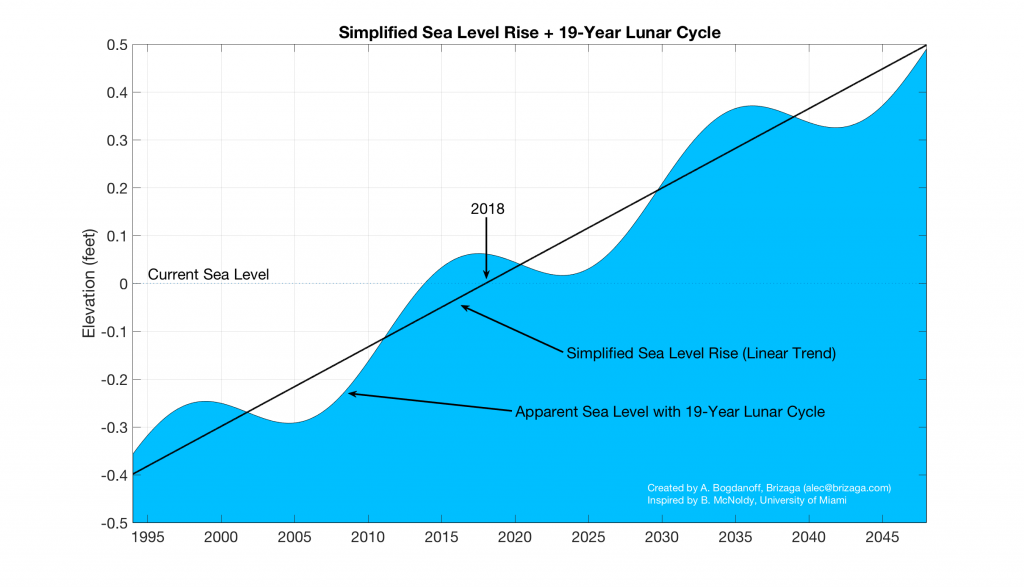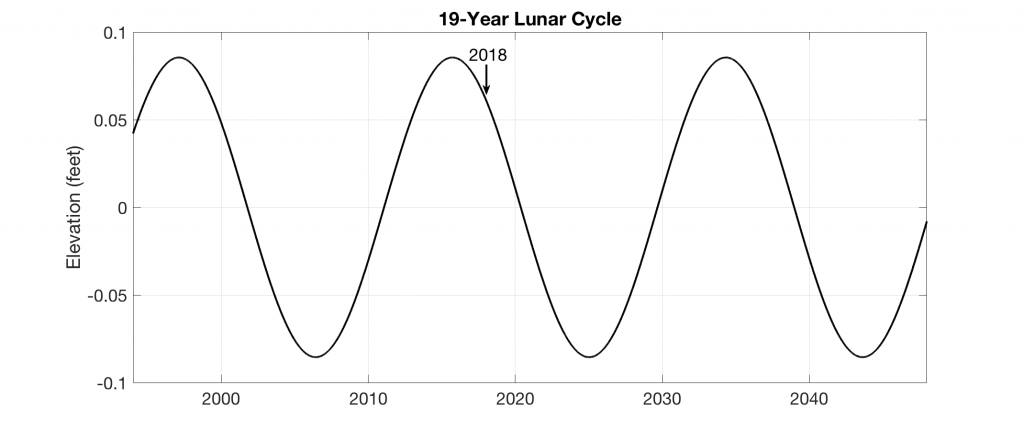Sea Level Falling until 2024

Apparent sea level (at peak high tide) results from global sea level change, plus the variations in the various tide cycles. In 2018 we are in the “down phase” of a 19-year tidal pattern which may cause sea level to appear to go down. We must be prepared for the next extraordinary rise starting in 2025.
Over the last decade sea level has been rising faster and faster. I often hear from property owners in low-lying coastal communities who are very worried about the increasing rate and where it is headed. Most are surprised to learn that from now until 2024, that peak daily sea levels – at peak high tide – will appear to go down in most places. We need to understand the rather mysterious 19-year tide cycle that is having this effect. Otherwise we will be unprepared for the nine year period starting in 2025 when it will again rise extra fast, flooding properties globally. Few appreciate this, but it is powerful and important to understand.
Recall that the daily high tides vary each month due to the pull of the moon – and the sun – on our oceans. (For reference, my post last week explained the basics of tides, “Why High Tide Can be Zero to 30 feet“.) Most people know there is a daily high tide. Many understand that a peak monthly high tide occurs at the full moon or new moon when the Sun and Moon are in alignment and pull together. But the forces and angles of the Moon and Sun relative to the Earth are very different, causing varying amounts of gravitational pull from one month to the next. This affects the height of the ‘high water mark’ at highest daily tide. It takes almost 19 years for a full pattern to occur.
Technically this is referred to as the lunar nodal cycle, and causes what oceanographers refer to as a “tidal epoch” illustrated below. Each half of the nineteen years, the up cycle and down cycle are consistent, each lasting about 9 1/2 years. The variation up and down in ocean height with the daily high and low tide’s is quite significant, about 2 1/2 inches (about 6 cm). In other words, on certain days over the nineteen year period the tides are exaggerated, adding to the perception of sea level. This needs to be put in context.

19-year lunar nodal cycle causes a predictable variance (exaggeration) in tide height of about 2 1/2 inches (6 cm).
Global average sea level is about ten inches higher than a century ago, but the rate is actually increasing now due to the thermal expansion of seawater, plus the melting glaciers and ice sheets. Presently the global average rate of real sea level rise due to increasing volume of water in the oceans is almost 2 inches (5 cm) per decade. During the recent up phase of the lunar nodal cycle, 2007 – 2015, the 2 1/2 inches from this tidal cycle added to the roughly 2 inches of global average sea level rise, caused about 4 1/2 inches of combined higher sea level at peak high tide. This was the seemingly very high rate of sea level in the period ending in about 2015.
Now in 2018 we are in a down phase – global sea level will still go up another 2 inches largely from the melting ice, but the 19 year cycle has reversed and is going back down 2 1/2 inches over these nine years, making it appear to have a net decrease of half an inch. This period with slowing sea level, may confuse, or even provide support for those that do not believe in climate change.
But in the next up phase from 2025 – 2034, it will again appear to be another 4 1/2 inches a decade, understandably causing confusion and surprising quite a number of people.
To visualize this, my colleague Alec Bogdanoff created the blue graph at the top of this article. It is a highly simplified diagram of how sea level might appear at a particular location assuming that the rate of global sea level rise stays constant – as shown by the straight diagonal line. It merely combines the 19-year lunar-solar cycle with a constant rate of sea level rise. It is easy to see that in 2018, net sea level may go down as part of this eight or nine year down phase. (NOTE: This simplified illustration ignores effects from changing ocean currents and land subsidence or uplift in particular locations.)
It is really important that we understand this mysterious phenomenon, so that we are prepared for the period starting in 2025 when the rate of rise comes back with even more force.
Surprisingly this is not a new concept. This modest variation in a recurring nineteen year pattern was observed by the ancient astronomers, starting with the Babylonians almost three thousand years ago. The pattern is called the Metonic Cycle, named for the Greek astronomer, Meton of Athens who documented the cycle in 432 BC, almost 2,500 years ago. In fact, the Meton cycle is the basis of the Greek, Chinese, and Hebrew calendars.
Long-term rising sea level will be one of the greatest challenges this century. To prepare our families, communities, economies, and national security for the future, we must take advantage of this perspective. Hardly anyone recognizes this phenomenon. (This is an example of the work we will be doing in the new International Sea Level Institute.)
To recap in very simple terms:
- The period 2007 – 2015 was extraordinary with unusually high rates of apparent sea level rise, amplified at peak high tide by the up-phase of the 19-year lunar nodal cycle.
- The present nine year down phase, from 2015 – 2024 will see a greatly reduced rate of rise and in some places an actual net decrease in sea level. Rather than leading us to believe the problem is lessened or gone, we should view this lull as giving us time to prepare better for the next up phase.
- From 2025 – 2034 will be the next up phase. Combined with the quickening rate of ice melting in Alaska, Greenland and West Antarctica sea level rise will almost certainly be even faster than at present. Combined with the 19 year lunar nodal cycle, the rate of rising sea level will be even faster than the recent up phase. Indeed it will be quite unlike anything we have ever seen.
Many aspects of climate change are unpredictable, but this one is completely predictable. It’s time to get to work –– to plan, and to adapt. Future flooding will be even worse than what we have seen in recent years. Whether we operate with enlightenment or ignorance will determine our legacy. We should take advantage of this “intermission” and intelligently plan for the wild ride ahead. “Buckle up.”
